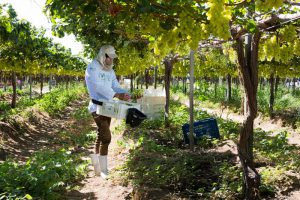Brazil may not be the first name to come to mind when talking about wine, but that is changing fast. The country’s production soared from 360 million liters in 2019 to 430 million liters last year. It was the biggest increase registered by a member of the International Organization of Vine and Wine (OIV) in the period.
According to the entity, Brazil represents only 2% of the world’s market, but it has registered a growth of 18.4% in consumption in 2020.
During recent lockdown periods, the sector saw its stocks practically disappear. Deunir Argenta, president of the Brazilian Union of Viticulture (UVIBRA), recognizes how staying at home for longer periods changed consumption habits and benefited sales.
“The rise in the value of the dollar (compared to the Brazilian real) also helped, making Brazilians taste and discover local wine, approving the experience, both for its quality and for the good price,” he says.
The demand for national wines was so expressive that the sector is currently facing a shortage of bottles.
Quality
In 2021 alone, Brazil received more than 160 international wine prizes. At the Decanter World Wines Awards 2021, one of the biggest wine contests in the world, Brazil got one gold, six silver, and 35 bronze medals. Over 18 thousand labels from 56 countries participated in the competition.

“For reasons related to soil, water, labor, culture, and global location, we can produce a great variety of grapes with high quality. And for the same reasons we produce excellent still wines, sparkling wines, and juices for national and international markets,” defends Elson Schneider, president of the Serra Gaúcha Rural Union.
Almost 100% of Brazil’s grape and wine production used to be concentrated in Serra Gaúcha, a region in the Rio Grande do Sul state. But nowadays other states are investing in viticulture. “Today we have around 80% of the national production; the other 20% are in the São Francisco Valley, in Minas Gerais, in Brasília, in São Paulo, in Santa Catarina and Paraná. We observe that the fruit adapts greatly throughout the territory,” explains Schneider.
History
It is believed that the history of wine in Brazil began shortly after the arrival of the Portuguese. In the 1530s, the first Portuguese vine seedlings were planted in Serra do Mar, on the Southeast coast.
Tropical weather did not favor the plantation, and that first attempt was a complete failure. It was only when the plantation moved to milder climates that production began to show results.

Until today, most Brazilian wineries are linked to European ancestors, who for several generations took up residence in the country. That’s the story of the Cainelli Winery, from Bento Gonçalves, also in Rio Grande do Sul. In the late 1920s, the first Cainellis arrived in Brazil from Italy, as part of the mass immigration process promoted by the Brazilian State.
At the time, 11 brothers were shareholders and managed the company together. It went bankrupt in the 1960s, but it stayed in the hearts and minds of the family.
Several years later, Roberto Cainelli Junior and his father, Roberto Cainelli, decided to reactivate the winery. For around eight years, they invested in studies, consultancies, and tests, and in 2012 they officially reopened Cainelli’s production.
“We love the culture of wine and we want to bring a positive experience to as many people as possible,” says Junior. Their winery promotes wine tourism in the region of Bento Gonçalves and has several initiatives to educate and stimulate wine lovers.
“In 2020 Brazilians did what we wanted the most: they opened national bottles, and that allowed them to experience the excellent quality of our wines,” celebrates him.